Yellowstone National Park
A Photo Journal of America's First and
Best National Park
Article Date: January, 2015
Article and Photography by Mark Quasius
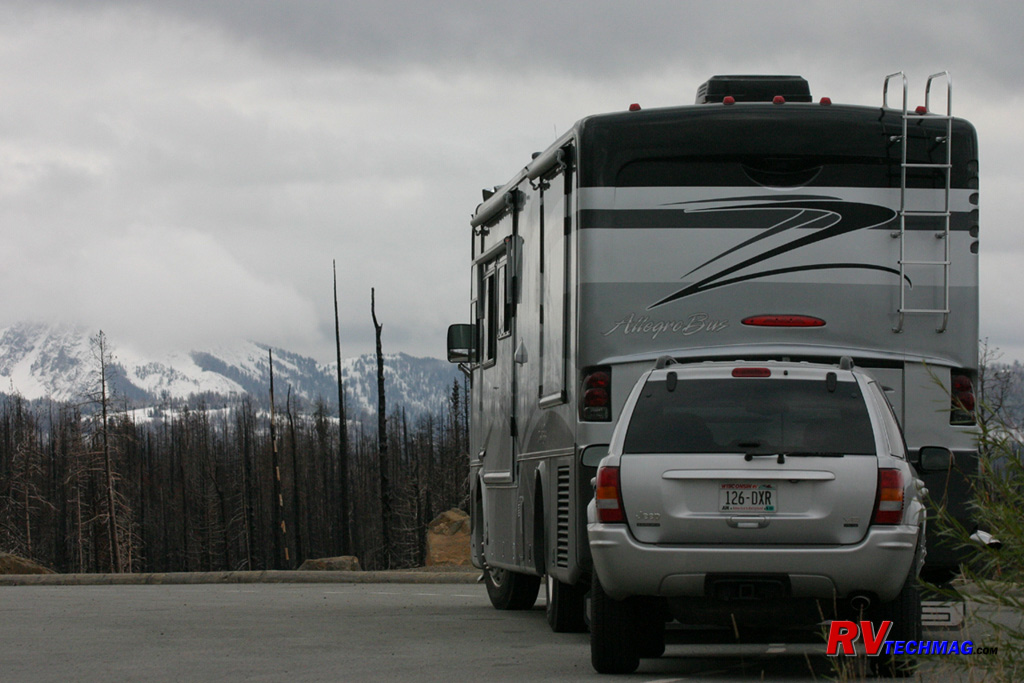
Lake Yellowstone and Hayden Valley
Yellowstone Lake is very unique. At 132 square miles it's classed as the largest high elevation lake (over 7,000') in North
America. At 7,733' above sea level it remains frozen for nearly half of the year and thaws in late May or early June. If all of the water were drained
out of Yellowstone Lake it would closely mirror what is now found in Yellowstone. The floor of the lake is covered with geysers, hot springs, and
fumaroles. When exploring recently with a submersible robot submarine a 390' deep canyon was found just east of Stevenson Island. Prior to this the
deepest spot was thought to be 320' at West Thumb. The hottest spot was found at Mary Bay where hollow pipes or silica chimneys were found spewing
water at 252 degree Fahrenheit.
The grand Lake Hotel, sits on its shores, looking out across the clear blue waters as the Absaroka Mountains form the perfect
backdrop. Nearby Fishing Bridge is where the Yellowstone River begins its northerly flow, leaving the lake for the waterfalls of the Canyon area.
This headwaters is also the spawning grounds for the Cutthroat Trout that ply these waters and is a popular spot for Pelicans, Moose, and Trumpeter
Swans. From the Fishing Bridge junction one can travel south along the shoreline to West Thumb and Grant Village or a turn to the north will bring
you through the abundant wildlife of Hayden Valley on your way to Canyon. Head east and shortly after Lake Village appears, with the impressive
Lake Hotel, and you'll cross Sylvan Pass on your way out as you climb, then descend over the Absarokas before arriving at the East Entrance.
Hayden Valley is a large area where the Yellowstone River lazily meanders through. This spot is a popular grazing spot for
bison and elk due to the lush grassy meadows. It's also a popular spot for grizzly bear and wolves as they travel along the tree line looking for a
meal amongst the grazing animals upon its slopes. Waterfowl abound in these waters, pelicans, ducks, herons, and trumpeter swans are present. You'll
also see bald eagles soaring overhead searching for cutthroat trout or whatever else is on the menu.
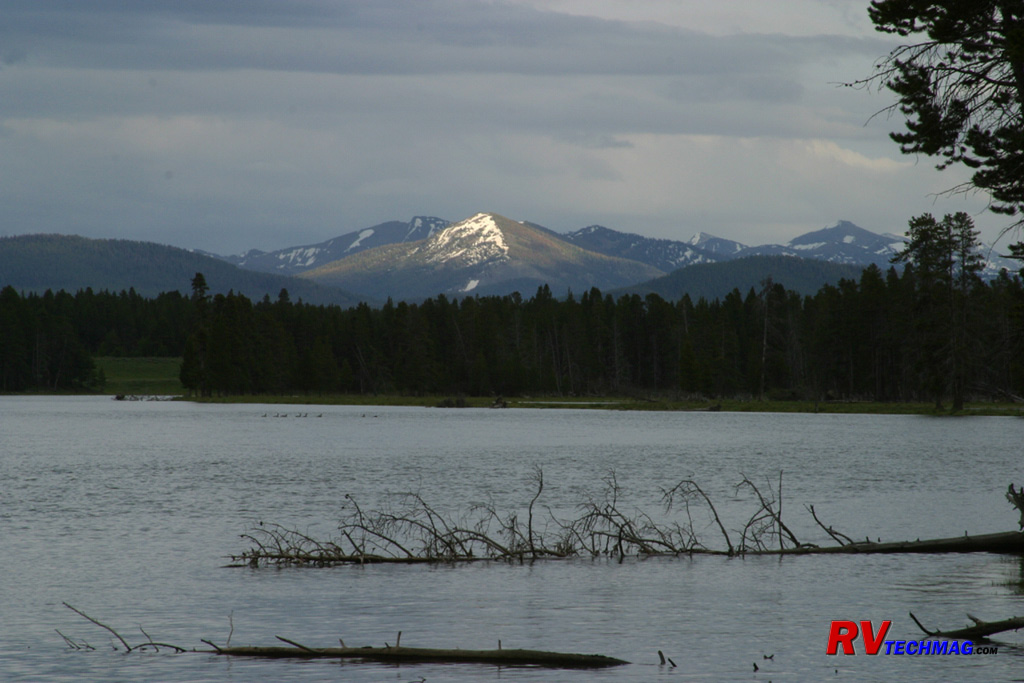
Yellowstone Lake
Yellowstone Lake is the largest high altitude lake in North America and is filled by the runoff from the surrounding mountains.
It is also fed boiling waters from the numerous vents in its base but these tepid waters do little to warm the cold waters that fill the lake. This is
not a lake well suited to swimming because its frigid waters will, and have, claimed lives from exposure to extreme cold temperatures. It is a great
lake for fishing and exploring and its setting easily makes it the crown jewel of alpine lakes. This July image shows how most of the snow has finally
melted from some of the surrounding peaks.
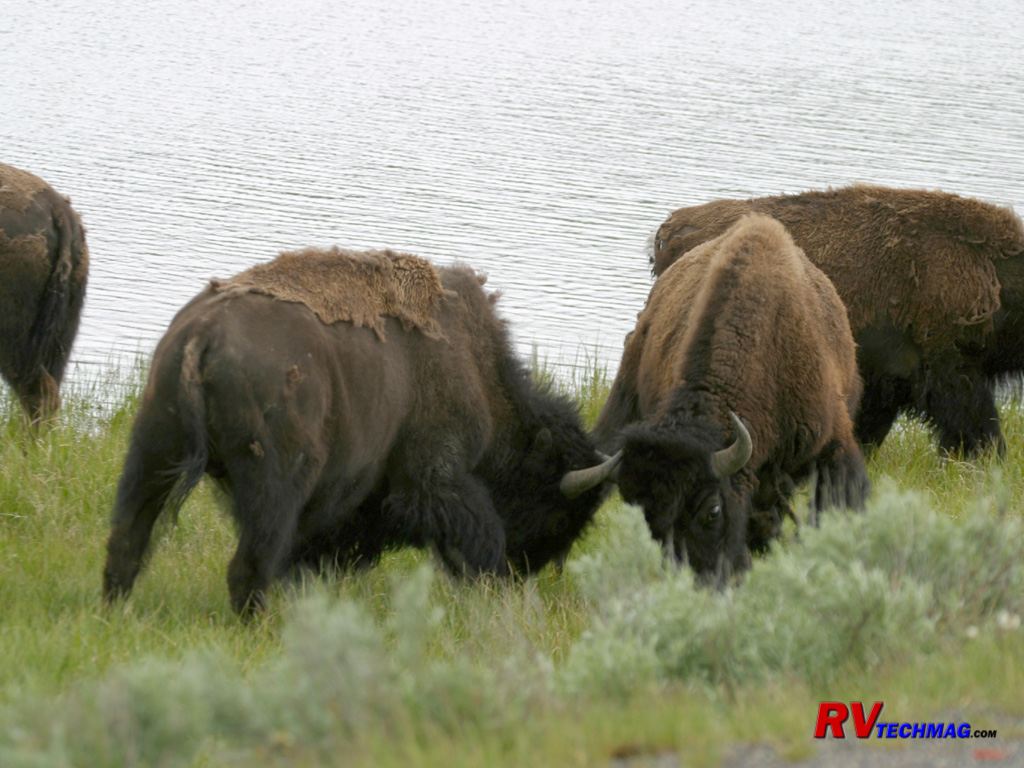
Bison Sparring
Bison practice expressing their dominance by sparring with one another. While bison rarely are injured by this routine their
massive neck muscles and body weight seems like two locomotives on a collision course at times. This sparring serves to establish dominance amongst
competing males for grazing and mating rites but also serves as practice when needed as a defensive maneuver from predators. Bison have been known to
flip a person 30' or more, sometimes landing them in trees so it's important to keep these powerful animals at a safe distance when viewing.
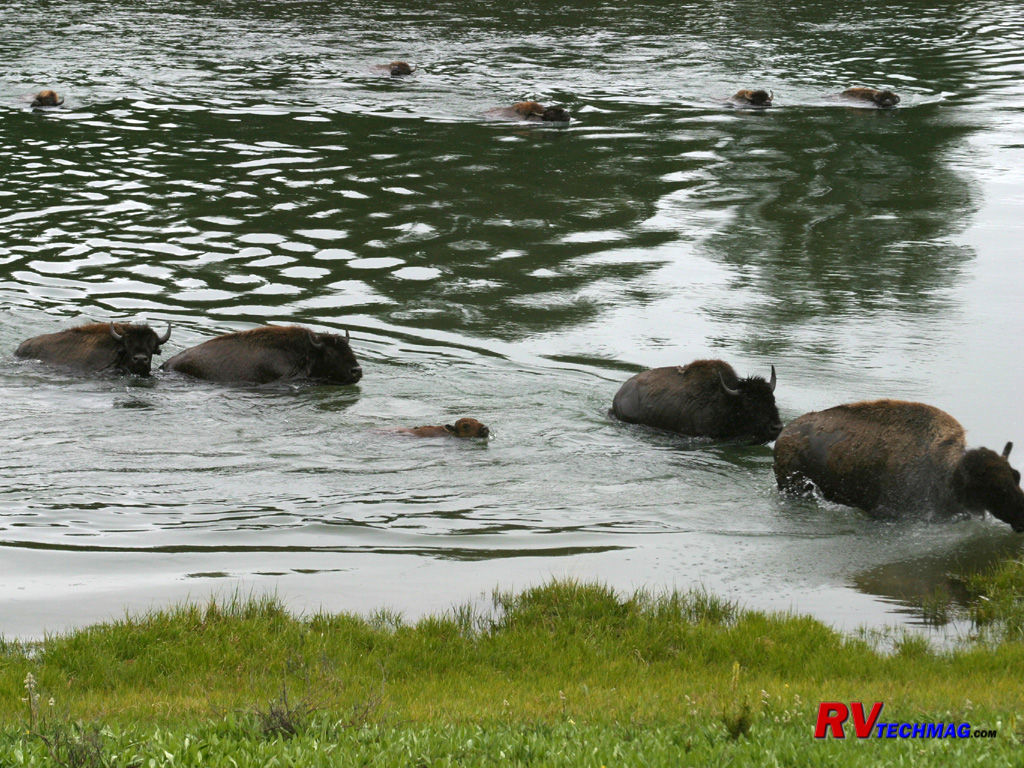
Bison Ford
Bison can swim. Every evening one herd can be found crossing the Yellowstone River at the north end of Hayden Valley as they
return from their grazing areas to bed down for the night in the Alum Creek vicinity. The current is swift but the bison are strong and they help
block the current for the young to cross.
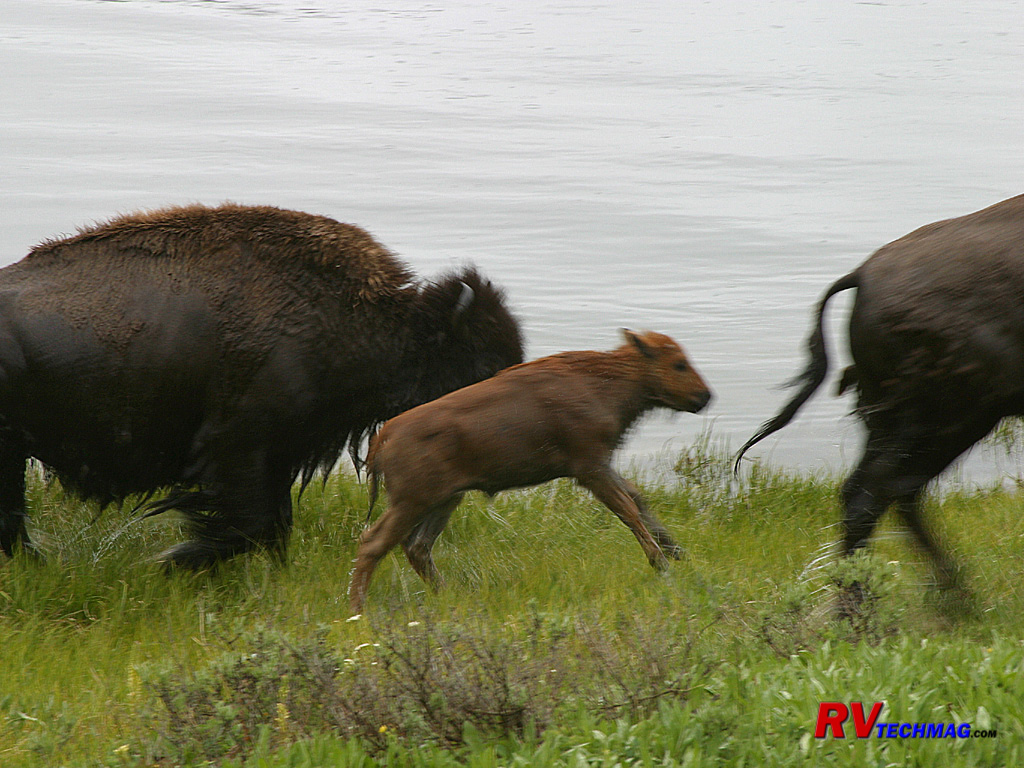
Bison Calf
After fording the cold Yellowstone River, this bison calf was jumping for joy after shaking his wet coat off. He was undoubtedly
glad to be out of the cold water.

Fishing Bridge RV Park
There are a number of campgrounds in Yellowstone but most are limited in size. The only full service campground inside the park
is the Fishing Bridge campground. Here there are full hookups and they can handle larger RVs. The sites are narrow so it can be a squeeze to fit and the
campground is packed tight, like a large parking lot, so it's not a prime place for rest and relaxation. However, most RVers are off exploring the park
unless sleeping so it's not the worst choice, especially for smaller RVs. Larger RVs will find better accommodations immediately outside the park but
Fishing Bridge does have an excellent central location to base camp from when exploring the park.
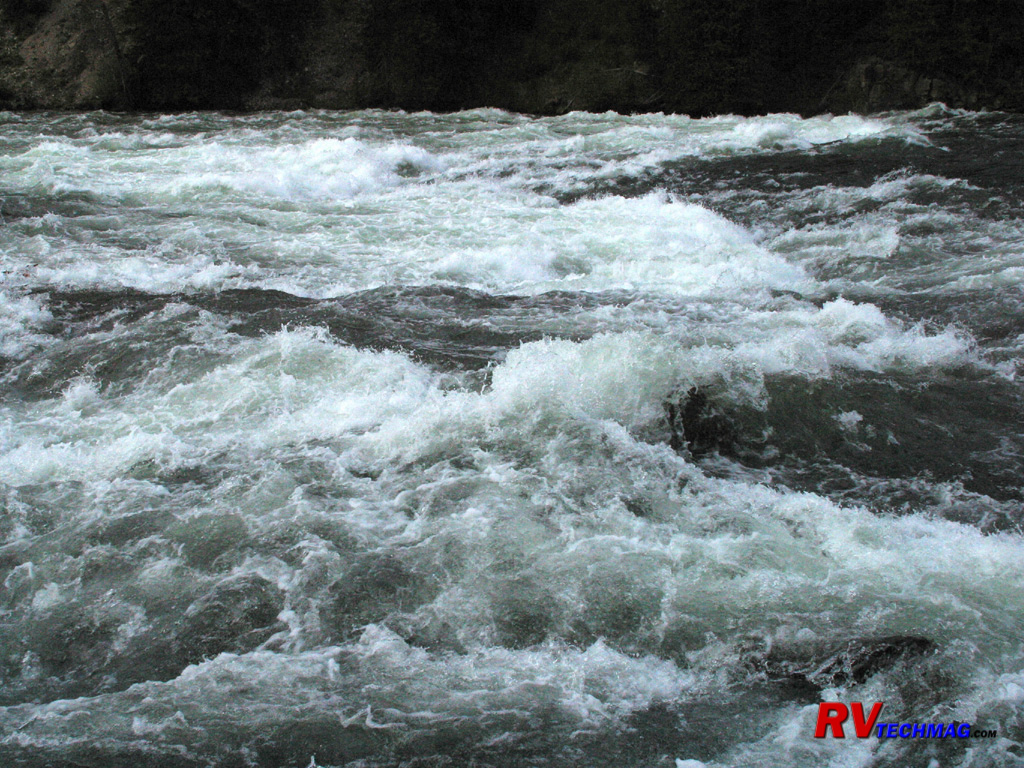
LeHardy Rapids
Located three miles north of Fishing Bridge is LeHardy Rapids. Each spring large numbers of cutthroat trout rest in the pools
there before jumping the rapids to reach their spawning grounds just under Fishing Bridge. These rapids were named for Paul LeHardy, a civilian
topographer with the Jones expedition of 1873. Jones and a partner started off on a raft with the intent of surveying the river, planning to meet the
rest of their party at the Lower Falls. Upon hitting the rapids, the raft capsized, and many of the supplies were lost, including guns, bedding, and
food. LeHardy and his partner saved what they could and continued their journey to the falls on foot.
The rapids became a popular visitor attraction when a boardwalk was built in 1984 providing access to the area. Due to
increased visitation, a group of harlequin ducks, which once frequented this area in spring, have not been seen for several years. The boardwalk has
consequently been closed in early spring to protect this sensitive habitat, but the harlequins have not returned.
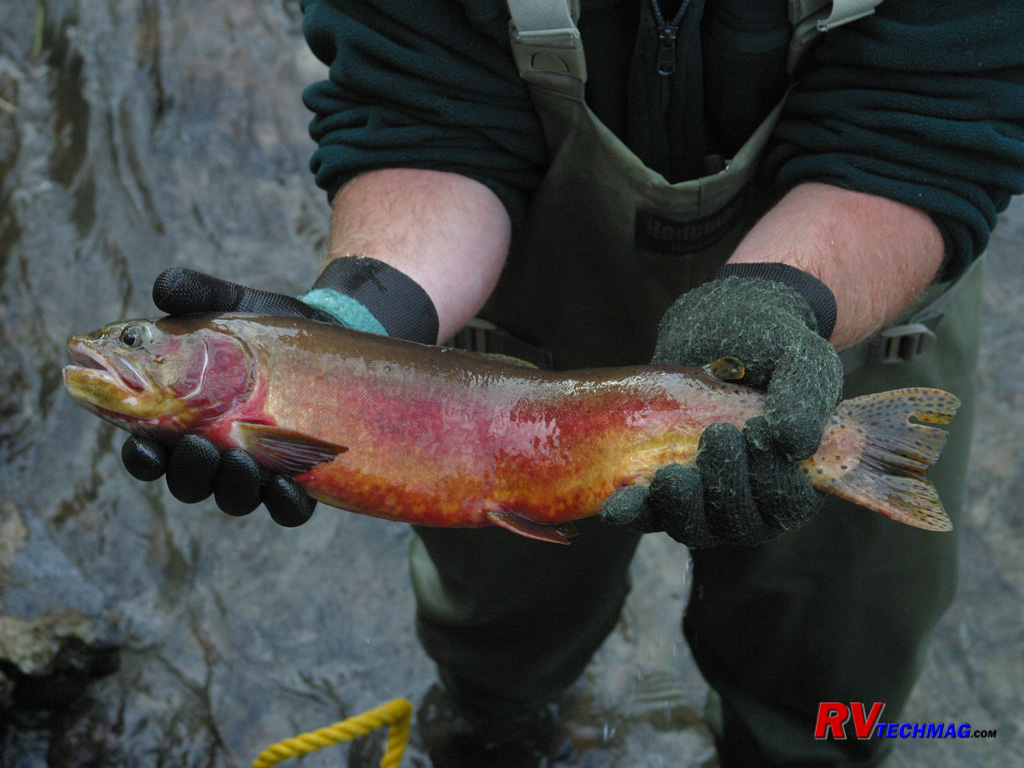
Cutthroat Trout
Cutthroat Trout are indigenous to the Yellowstone Lake as well as the many rivers and streams in this area. This trout was one
of many temporarily captured by Wyoming Fish and Game at LeHardy Rapids to collect eggs for use in hatcheries to repopulate areas where the trout are
disappearing. Recently Lake Trout have been dumped into Yellowstone Lake. These larger fish eat the young cutthroat trout, which are much smaller, so
a large scale netting operation is being conducted to remove the Lake Trout from the lake so that the Cutthroat have a better change at survival. This
red female shows the effects of fighting her way through the rocky rapids on the way to her spawning grounds.
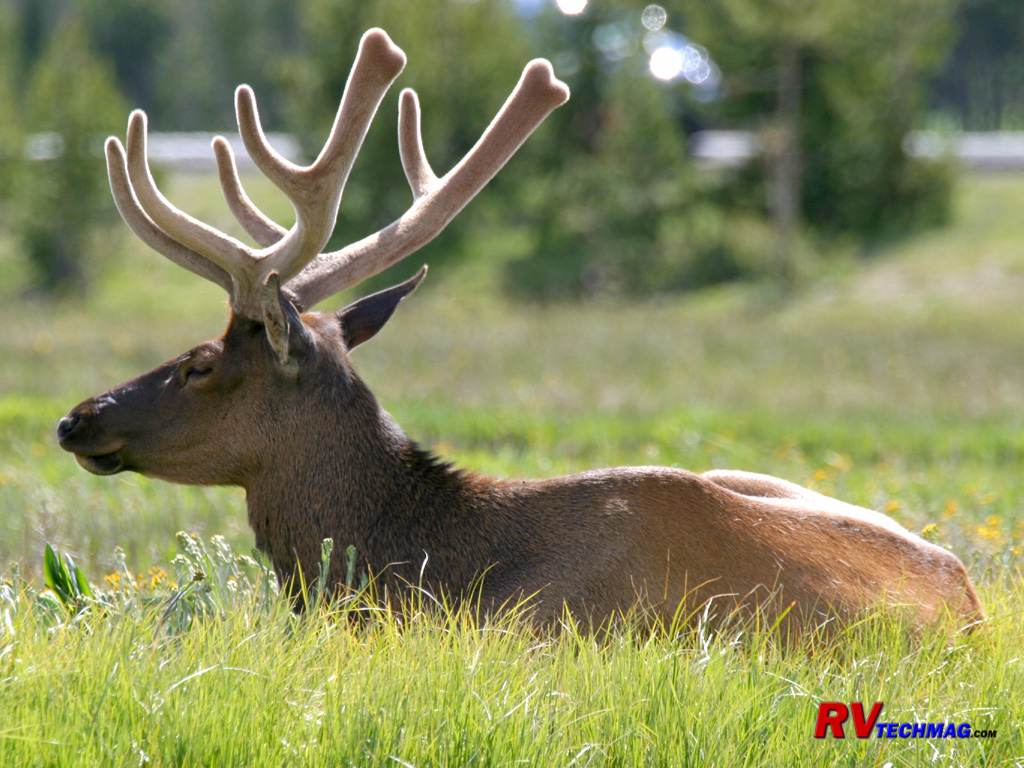
Bull Elk in Velvet
Male, or bull, elk shed their antlers at the beginning of every spring. They then grow new antlers through out the spring and
summer which mature into large impressive racks by the fall rut. As these antlers grow they are covered with blood vessels called velvet that nourish
the antlers as they grow. In the fall, when the antlers are done growing, this velvet dies and falls off as the bull elk rub their racks against trees
and brush. This image of a young bull was taken at West Thumb in the end of June.

Elk Cow at West Thumb
Female, or cow, elk hang around in family groups throughout the majority of the year while the bull elk hang out in bachelor
groups. These groups consist of a number of cow elk as well as their calves, which are born in the spring. This continues until the fall rut, when
the bulls separate from each other to gather their harems. This cow elk was grazing at West Thumb with a number of other cows and calves.
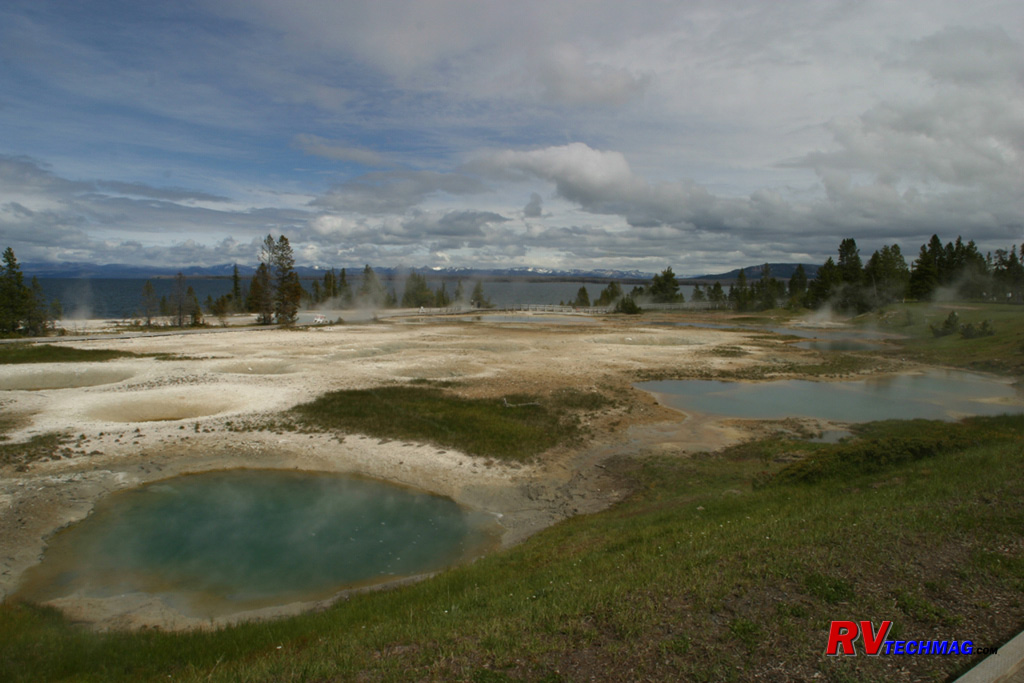
West Thumb Geyser Basin
If you look at a map of Yellowstone Lake you'll see that it's not perfectly round. Instead there is a section to the west
called West Thumb. This part of the lake is the deepest and the many thermal vents in its floor make it the hottest part of the lake. The West Thumb
geyser basin is found right on the shore of the lake. The boardwalk wraps around its circumference and follows the shoreline in places, where you can
see submerged geysers, such as Fishing Cone, right off the shore. There are many pools, geysers, and fumaroles in this area and it's also a place
where Trumpeter Swans can be seen from the shoreline.
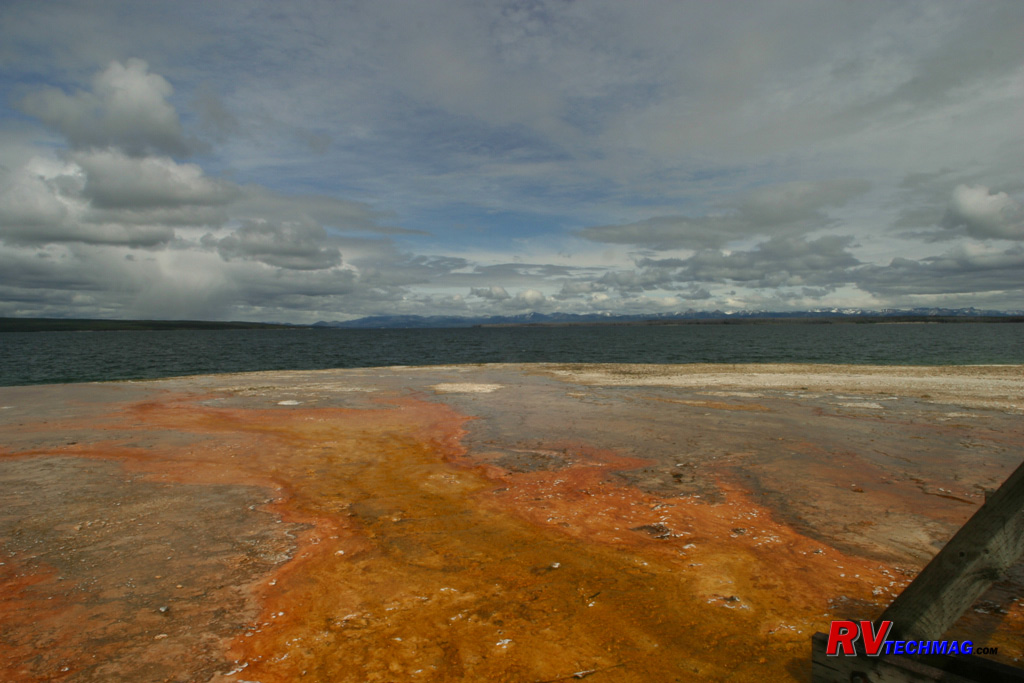
West Thumb Runoff
The continuous flow of hot water from West Thumb's thermal features has to go someplace and downhill is the logical solution.
The West Thumb basin pitches down slope to the shore of Yellowstone Lake and this image shows evidence of the iron and mineral content present in
this runoff.
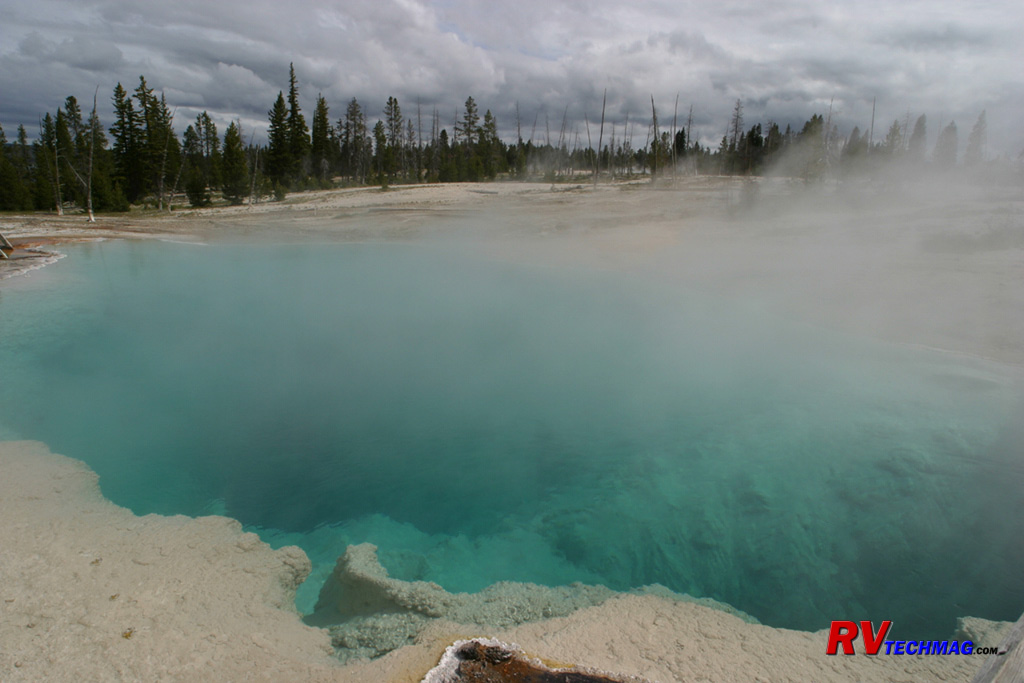
Blue Spring
This blue pool is typical of the hot springs present in Yellowstone. The boiling waters ooze from limestone caverns within the
ground. Unlike the geyser, there is no restriction to build up pressure so hot springs flow steadily rather than cycle. This 200 degree water steams
at it hits the cool fall air and partially hides it's vivid aqua color.
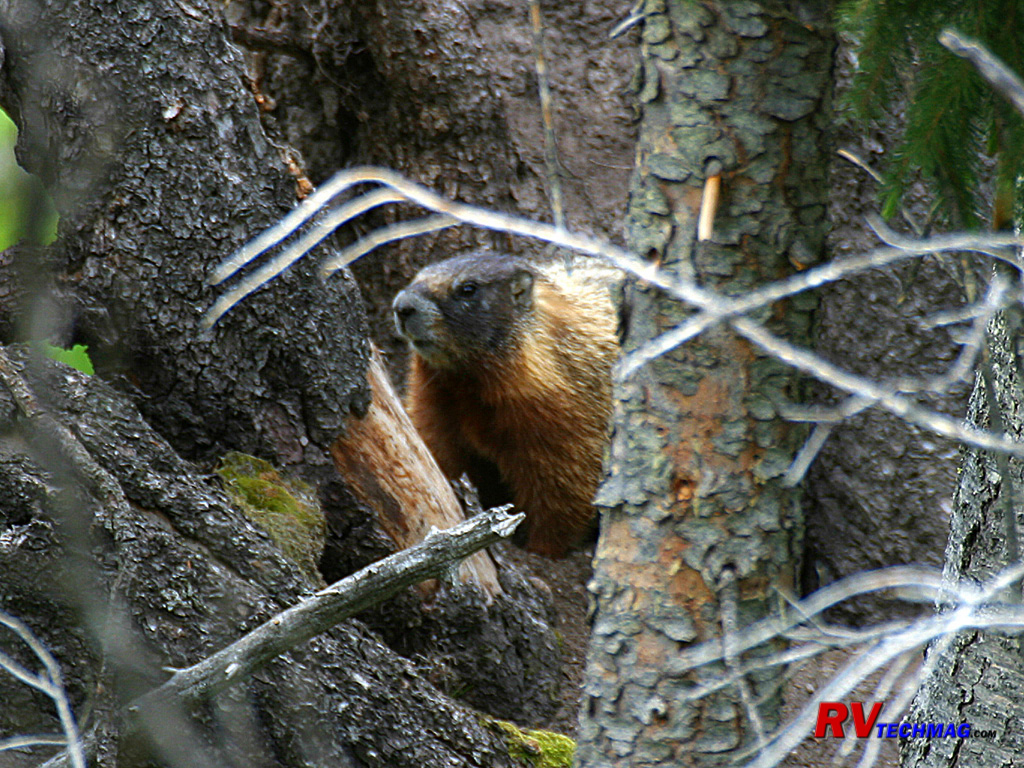
Yellow Bellied Marmot
Yellow bellied marmots are also known as Rock Chucks or Whistle Pigs. A relative of the Woodchuck, Marmots live in rocky
locations. The dig their burrows underground and always stay close to cover so that they can disappear should an eagle or coyote happen by.
Marmots are reclusive and generally pretty wary of people.
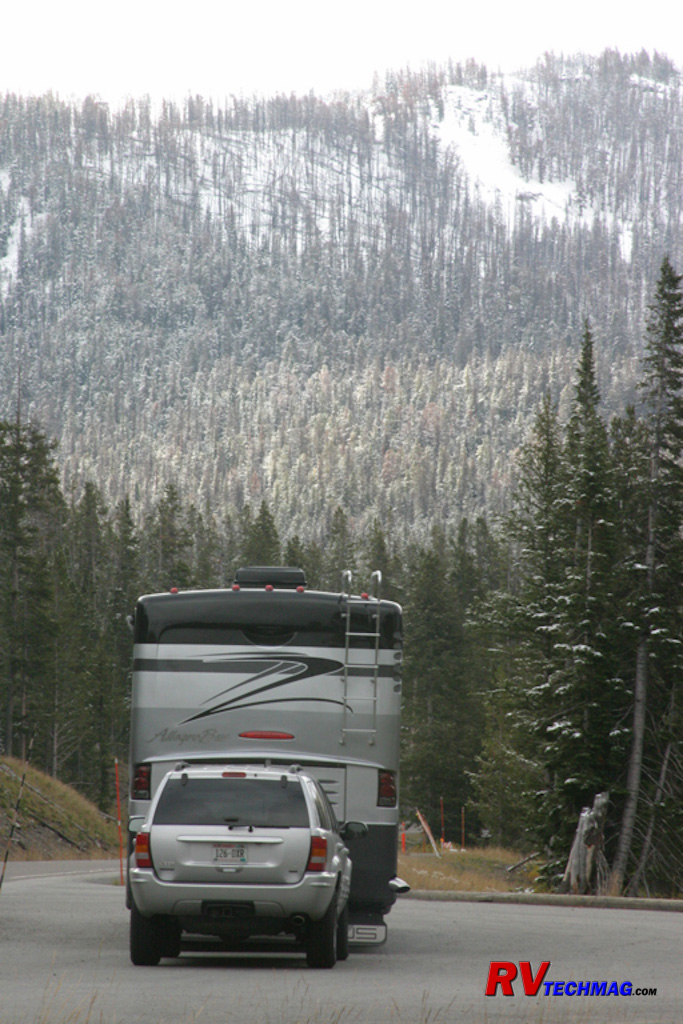
Sylvan Pass
Heading east from Fishing Bridge you'll need to cross the Absaroka mountain range to exit the park. This is done by crossing
Sylvan Pass. This image was taken in late September after a brief snowfall and shows the drive ahead. Sylvan Pass is doable with any vehicle but
there are areas where the view over the edge can be unnerving to someone not comfortable with heights.
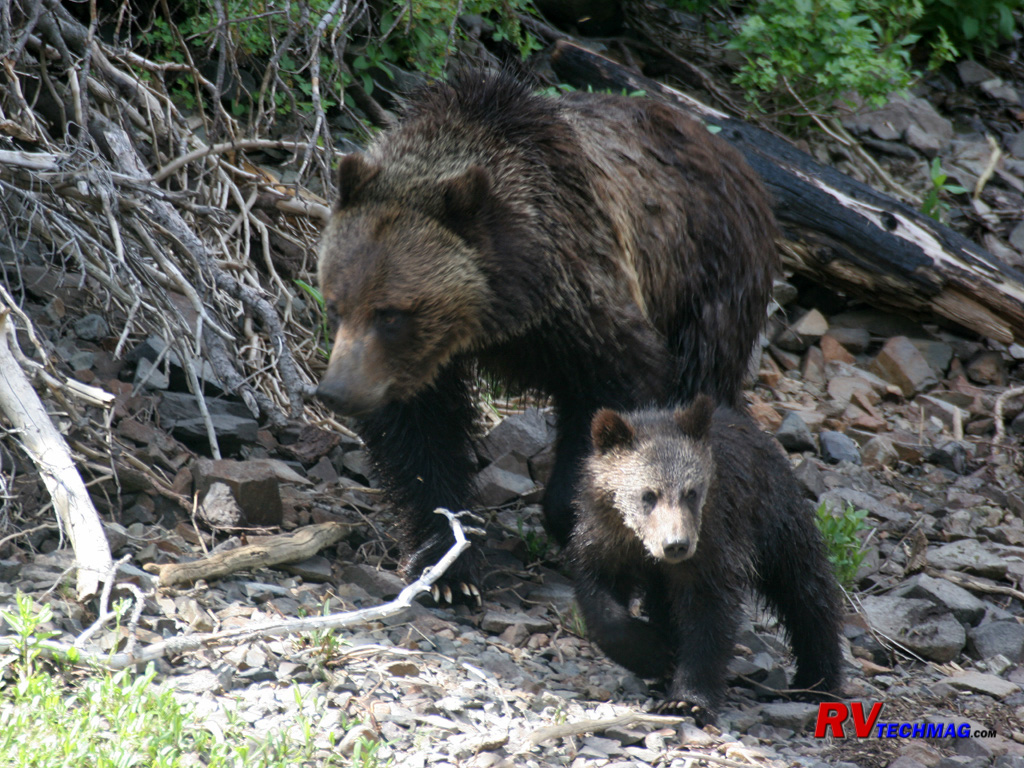
Grizzly Sow and Cub
This grizzly sow and cub were spotted shortly after descending from Sylvan Pass, near the east entrance to the park. The mother
was following the edge of a small lake as the cub followed closely behind. Grizzly cubs typically stay with their mothers for 2, and sometimes even 3
years before setting out on their own.
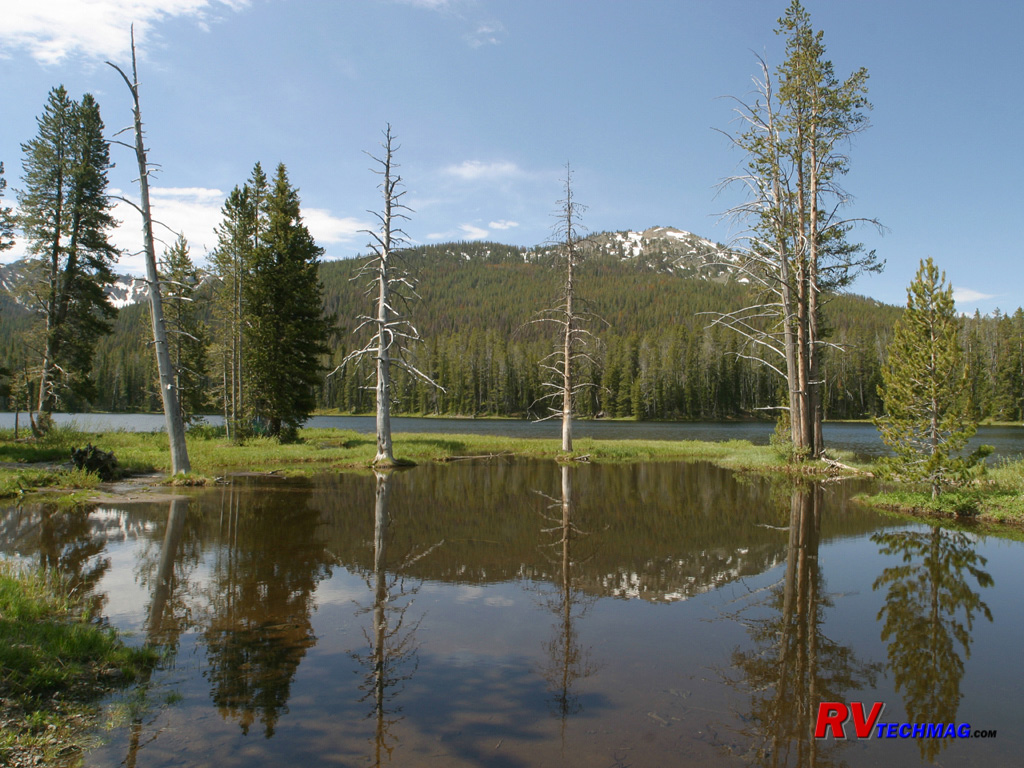
Sylvan Lake
Before beginning the climb out of the park, you'll pass by Sylvan Lake. This July setting shows the surrounding mountains as
well as the effects of forest fire and mineral contamination of trees. The reflection shows the Absaroka range in the distance.
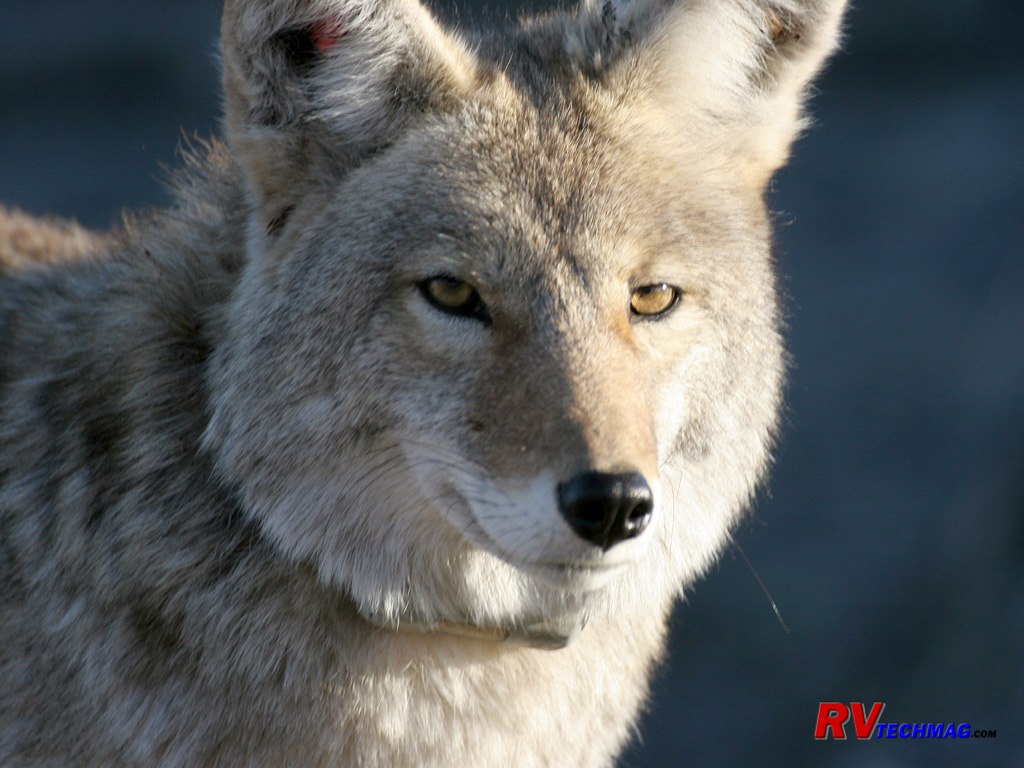
Coyote
This smaller cousin to the Gray Wolf has a tougher time finding food now that the wolves have been reintroduced to Yellowstone.
Still, they are thriving and feed on smaller rodents as well as scarps left from a bear or wolf kill left unattended.
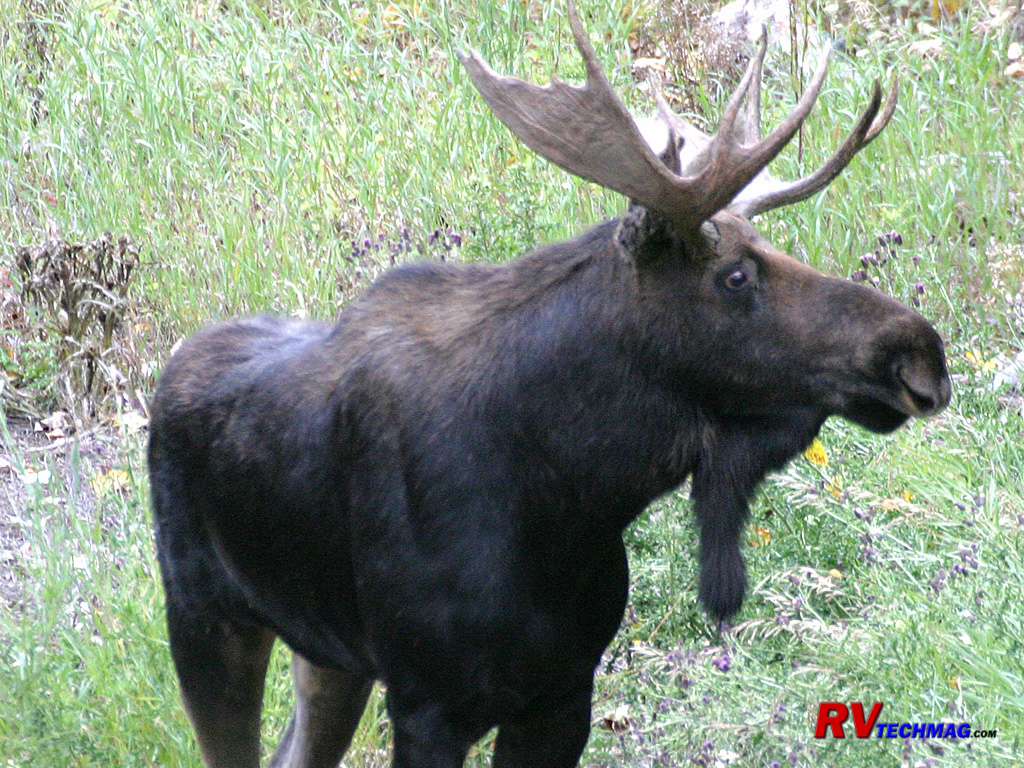
Bull Moose
These gangly looking creatures are found in aquatic settings such as marshes. Their huge snouts are perfect for picking up wet
vegetation from the bottom of marshes and streams and their tall legs and dark coloring keeps their body warm and out of the water. These tame looking
animals can be deceiving though and they don't care much for strangers and express that with strong, powerful hooves. Like elk, these ungulates also
shed their antlers annually.
Return to Home Page
If you enjoyed this article be sure to recommend RVtechMag.com to your friends, like us on Facebook or Twitter
or subscribe to our RSS feed.



|























